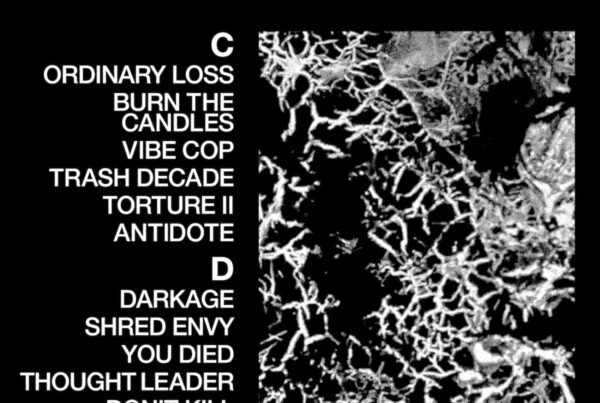Meeting at the crossroads of spiritual jazz, gospel soul, and ambient compositions is the powerful statement of Amen.
Release date: May 10, 2024 | Whited Sepulchre Records | Bandcamp | Facebook | Instagram | Twitter
Before hearing the work of Joy Guidry my only point of reference for the bassoon was Rainn Wilson and Only Murders in the Building. Radical Acceptance was my first experience with the bassoon as an actual musical instrument and not just a pop culture television reference. Talk about an introduction, this was like diving right into the deep end of what was even possible with the form.
Radical Acceptance the 2022 debut album by composer and musician Joy Guidry oscillates between modern classical, dark ambient, noise, field recording, and jazz. Traditionally bassoon is considered a complementary or backing instrument providing depth to the bass line. Joy however has a more radical take on what the instrument is capable of. Or as she put it to Jazz Speaks on moving from the classical world to the noise scene: ‘People were like, ‘I didn’t know bassoon could do that.’ And I was like, ‘I didn’t, either.’’
Joy’s new album Amen starts off with the nervous build up of “Psalm 138:7”, a vague and ominous hum. The wandering playful melody recalled to my mind the Arabian Dance scene of The Nutcracker’s second act. Joy makes excellent use of a sample early on Amen, much like “Down in the Valley” off of Radical Acceptance, helping to set the tone of the record and bring her vision into focus with the track “Pick and Choose”. Taken from a sermon by Pastor Dewey Smith on the hypocrisy of the church’s vilification of queer folk while simultaneously enjoying or benefiting from their work.
Thematically Amen is a very spiritual album which is made evident at the outset. The intro and outro tracks reference Bible passages: “Psalm 138:7”, ‘Though I walk in the midst of trouble, you preserve my life; you stretch out your hand against the wrath of my enemies, and your right hand delivers me.’ “Revelation 7:16-17”, ‘They shall hunger no more, neither thirst anymore; the sun shall not strike them, nor any scorching heat. For the Lamb in the midst of the throne will be their shepherd, and he will guide them to springs of living water, and God will wipe away every tear from their eyes.’ The subtext is clearly that of acceptance, perseverance, and the welcoming embrace of community.
Especially following the fiery spoken words of “Pick and Choose”, “Members Don’t Get Weary” takes on a devotional tone ‘Members don’t get weary / I’m going down to the river Jordan / when my work is done.’ With its swelling bramble of brass, drums, and just a touch of piano this “Members” is an easy highlight of the album.
Beyond the intro and outro tracks “Psalm” and “Revelation”, the bulk of the ambient experimentation on Amen is found on the tracks “It’s Ok To Let Me Go”, “Day By Day”, and “I Will Always Miss You” which taken together form a kind of triptych. Musical motifs and melodies reappear across these tracks like players entering and exiting the stage becoming familiar over time. “Revelations” closes the album with a hopeful twinkle and wobbly ethereal vocals. What could have been simply a forgettable outro instead becomes a warm hug invoking brilliant imagery of ascension beyond worldly concerns.
Amen is an ensemble project from start to finish. From the striking album cover presented by photographer Nykelle Devivo with hair by Jax Bryant, to the featured musicians too numerous to list. (Please see the albums Bandcamp page for all the artists involved.) Amen takes the raw energy of a group improv free jazz jam session and couples it with the direction of contemporary music production into a blend of chaotic control. The record has a structure that feels spontaneous and alive rather than coldly calculated and rigid.
Transformation is a kind of magic. Unlike the fantastical alchemical transmutation of turning lesser metals into gold, art is the very real magic of turning the mundane into the sublime. Synthesizing raw materials like paint and canvas or brass and wood into unique artistic works of majesty. This kind of transformation is the undertaking of Joy Guidry. Each of her projects bloom like a flower in the sun or a butterfly emerging from a chrysalis. Her live shows are part visual performance, part meditation, and all soul.
Jazz is sometimes referred to as the only true American art form. I mostly tend to agree, with the extension that blues which preceded jazz and hip hop which continues the tradition are all uniquely American creations. It could even be argued that rock and roll and country music owe their very existence to shared blues roots. However jazz and blues themselves were heavily influenced by many musical traditions from Africa, Europe, and the Caribbean filtered through the African American experience.
Like Radical Acceptance there is a backdrop of ambient, noise, and experimentation on Amen. But the focus this time around is much more centered on ‘different forms of southern Black American music. I wanted to lean heavily on my Texas, Louisiana, and Creole roots in this project.’ The tender heart at the core of this look at southern Black American music is largely found on two cover songs “Members Don’t Get Weary” and “Angels”.
“Members Don’t Get Weary” is an inspired rendition of the 1968 Max Roach track “Members, Don’t Git Weary” from his album of the same name. Max Roach was one of the most innovative and all time great drummers. He played with jazz legends such as Miles Davis and Duke Ellington. He helped create the bebop movement alongside Charlie Parker and Dizzy Gillespie. Max Roach was as big an influence on his contemporaries within jazz as he was on artists as varied as King Crimson, The Notorious B.I.G. and YES.
The choice of this song is especially poignant given it was recorded, much like today, in especially tumultuous times. The backdrop in 1968 was that of assassinations, civil rights protests, and the war in Vietnam. Sonically, much like Amen, “Members, Don’t Git Weary” was experimental in nature with Afro-spiritual influences. One could hardly think of a more appropriate selection to examine the roots of southern Black American music’s impact and legacy. Through Amen’s modern lens Joy’s unique vision as both performer and composer has breathed new life into a classic.
The original “Members” has a more mournful somber beginning working towards a climax of optimism at the end. Versus the almost labor anthem, sing along, buildup to a triumphant declaration of self-empowerment on Amen. In the original mix the vocals are in competition with the brass and especially the drums which wrestle for the spotlight to the point of being overpowering. Whereas on Amen the vocals are dominant, fiercely in the spotlight backed up by a still vibrant brass and drums section.
“Angels” is a heavenly rendition of a Cynthia Liggins Thomas song which itself is based on a rich history of call-and-response music within the Baptist Church and African music throughout time. As Cynthia elaborates:
‘The Lyrics of this song “Angels” were written and set to an old familiar Call-and-Response melody. I’m old enough to have experienced this type of congregational singing; the ‘a cappella,’ hand-clapping, foot-stomping, soul-stirring singing that was the norm in the Baptist Churches I grew up in. What I didn’t know, at that time, was that this style of music was passed on to us by our ancestors and we were just doing what came naturally to us.’
Played by Joy and friends, “Angels” takes on the powerful force of a congregation. After about two minutes of soulful choir an abrupt drum fill ushers in a piano takeover with brass backup. The track moves lushly forward from here. Instruments rising and falling in and out of the mix until the choir returns once again with another injection of soul. ‘Everywhere I go (Everywhere I go) / There’s an angel there (There’s an angel there)’.
Amen is a triumphant bold declaration. The album sits in dual conversation with the listener by inspiring joy and with the rich history that inspired its creation. Guided by her ancestors Joy Guidry and the numerous artists who lent their talent to this project have joined together in a brilliant musical communion. Amen.







2 Comments